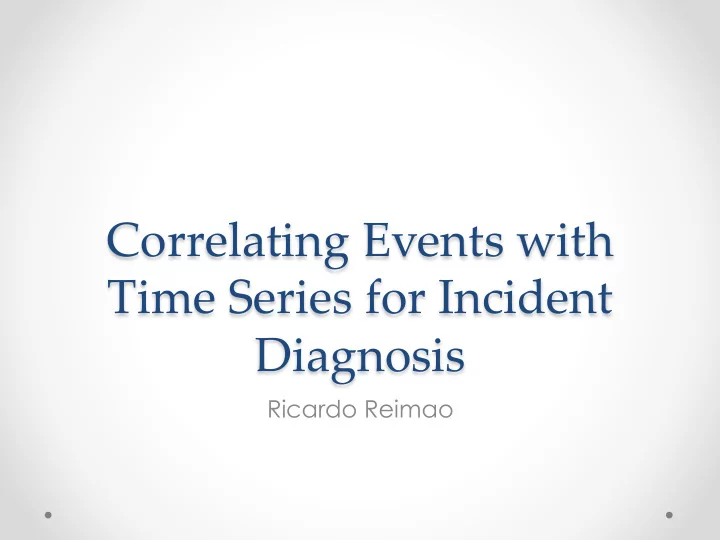

Correlating Events with Time Series for Incident Diagnosis Ricardo Reimao
Idea: Identifying Pa=erns in Series and Events PPT freezes Memory Usage CPU Usage Open PPT User kills process
Problem! • How to correlate events with temporal series? • How to identify anomalous behavior? • How to predict incident causes? PPT freezes Memory Usage Series 1: CPU Usage Series 2: Memory Usage Event Series: Windows logs CPU Usage Open PPT User kills process
Formalizing the Problem
Three Main Questions • Existence Dependency o “Is there a correlation between the event sequence and the time series?” o “Does opening powerpoint affect my CPU usage?” • Temporal Order of Dependency o “Does X influences in Y? Or Y influences in X?” o “The powerpoint freezes because the memory usage is high? Or the memory usage is high because the powerpoint is frozen?” • Monotonic Effect of Dependency o “Does the event impact negatively or positively on the measure?” o “When I open powerpoint, does the memory usage increases or decreases?”
Subset definitions • L-Front: The sub-series BEFORE the event • L-Rear: The sub-series AFTER the event • Θ : A set of random sub-series • k: Size of the sub-sets k k CPU Usage L-Rear Θ1 Θ2 Θ3 L-Front
Definition 1 “An event sequence E and a time Series S are correlated and • E often occurs after changes of S (S > E) if and only if the probabilistic distribution L-Front is statistically different from the randomly sampled Θ . CPU Usage L-Rear Θ2 Θ3 L-Front
Definition 2 “An event sequence E and a time series S are correlated and • E often occurs before the changes of S ( E > S ), if and only if the probabilistic distribution of L-Rear is statistically different from the randomly sampled sub-series Θ and the probabilistic distribution of L-Front is not statistically different from Θ .” CPU Usage L-Rear Θ1 Θ2 Θ3 L-Front
Definition 3 • An event sequence E and a time series S are correlated ( E ~ S ) if there is a relationship such as E > S or S > E Definition 4 • If E > S (or S > E ) and the event occurrences of E are related to significant value increases of S, we denote the correlation as E +> S. If S decreases, we denote the correlation as: E -> S
Challenge: How to test if L-Rear are statistically similar to Θ?
Approach: Two Sample Problem
What is Two Sample Problem? • Multivariate two-sample hypothesis-testing problem • Objective: Identify if two samples are from the same distribution • In our context: o Check if L-Rear and Θ are from the same distribution o Check if L-Front and Θ are from the same distribution • Two Hypothesis: o H 0 : S = Θ (The series and Θ are from the same distribution, or in other words, S and Θ are statistically equal) o H 1 : S ≠ Θ (The series and Θ are from different distributions, or in other words, S and Θ are statistically different)
How to check? Nearest Neighbor! • Why? • Verify the distance between an item and items in a database • Process: o Generate the subset of L-Front/L-Rear o Generate the subset of Θ o Concatenate L-Front/L-Rear and Θ (this becomes the DB) o Whenever a new item A (event + L-Front + L-Rear) is tested: • Use k-NN to check which item is more similar to A • If the closest item is an item of Θ , then there’s no correlation • Else, the item may be correlation
Monotonicity Check • To check the monotonic effect, a new artifact is introduced: t score • Idea: Measure “how big is the impact” of E in S. • If t score is higher than a threshold, then: E +> S • If t score is lower than a threshold, then: E -> S
Algorithm
Inputs/Outputs • Input: o Event vector E = (e 1 , e 2 , … , e n ) o Time Series S = (s 1 , s 2 , … , s m ) o Subseries length k • Output: o Correlation flag C o Correlation direction D o Effect type t Important: ‘k’ (subseries length) and n (number of knn • neighbours to evaluate) have high impact on performance!
General Idea • Test L-Front and Θ • Test L-Rear and Θ • If correlation is found: o Verify t score to identify direction o Return
Empirical Evaluation
Previous Works • Pearson Correlation o One of the most used methods for measuring correlation between two time series o Cannot be directly used to correlate event and series data • Need to transform event data into a serie • J-measure Correlation o One of the most used methods for measuring correlation between event data o Cannot be directly used to correlate event and series data • Need to transform series into event data
Tests in a Controlled Environment - Person did not capture some correlations - Person does not give you the direction of the correlation - J-Measure did not identify correlation in one whole series
Tests in Real-World Environments Evaluation Metric:
Summary
Concept Summary • L-Front: The sub-series BEFORE the event • L-Rear: The sub-series AFTER the event • Θ : A set of random sub-series • k: Size of the sub-sets k k CPU Usage L-Rear Θ1 Θ2 Θ3 L-Front
Process Compare L- Identify Identify Identify Identify L- Generate Front/L-Rear Correlation Direction Monotonicity Front/L-Rear Random Θ to Θ (F/R=Θ?) (F=Θ? R=Θ?) (Tscore)
Pros | Cons Correlate time series and Utilizes a slow-search method: event data Nearest Neighbors Identify not only correlation, but Does not consider the event also direction and monotonicity combination problem Can be applied against multiple time series More effective then previous works (Pearson and J-Measure)
Questions? Ricardo Reimao
Recommend
More recommend